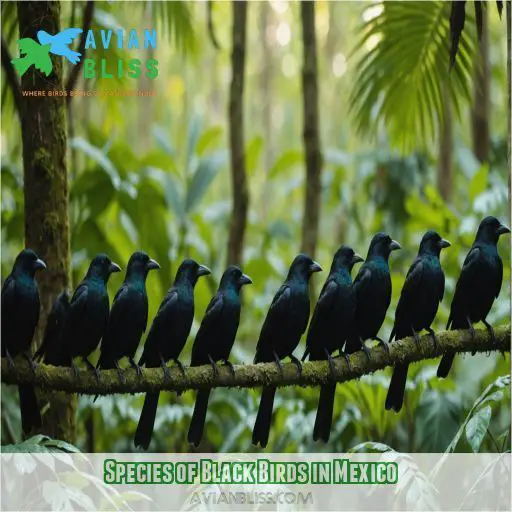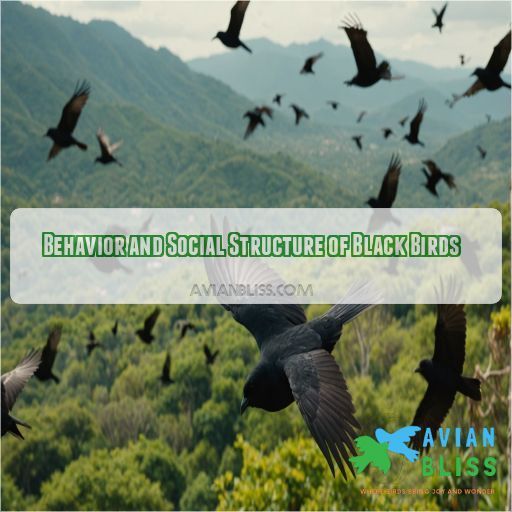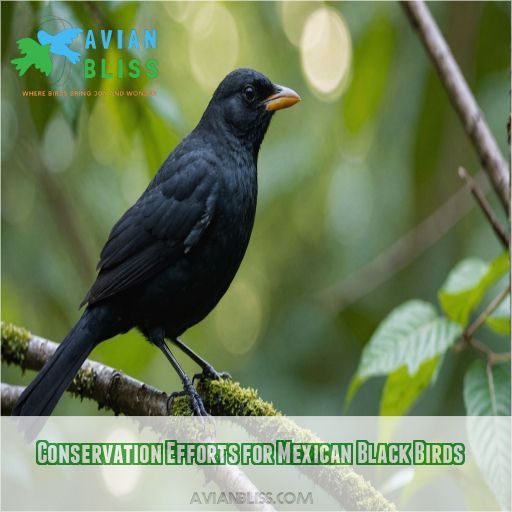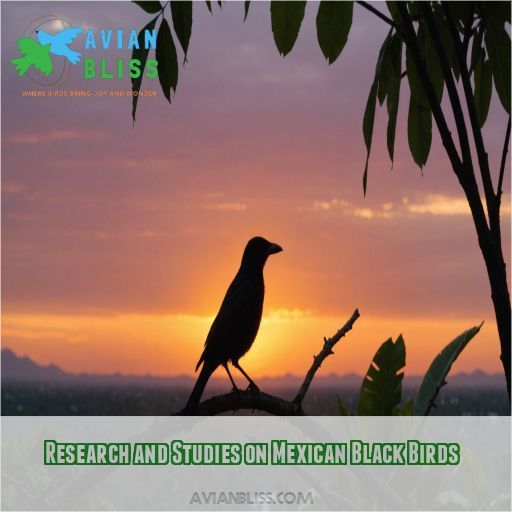This site is supported by our readers. We may earn a commission, at no cost to you, if you purchase through links.
 You’re on the hunt for some sleek and mysterious black birds in Mexico!
You’re on the hunt for some sleek and mysterious black birds in Mexico!
Well, you’ve come to the right place!
As you explore the country’s diverse landscapes, you’ll spot five stunning species that’ll make your birdwatching dreams come true.
There’s the glossy Great-tailed Grackle, the vibrant Yellow-headed Blackbird, the bold Red-winged Blackbird, the cunning Brown-headed Cowbird, and the urbane Brewer’s Blackbird.
Each one has its own unique personality and adaptations, making them a thrill to observe.
So, which one of these Black birds in Mexico will become your new favorite feathered friend?
The surprises are just winging their way in!
Table Of Contents
- Key Takeaways
- Species of Black Birds in Mexico
- Habitat and Distribution of Mexican Black Birds
- Behavior and Social Structure of Black Birds
- Ecological Impact of Black Birds in Mexico
- Conservation Efforts for Mexican Black Birds
- Cultural Significance of Black Birds in Mexico
- Challenges Facing Black Birds in Mexico
- Migratory Patterns of Mexican Black Birds
- Black Bird Adaptations to Mexican Environments
- Research and Studies on Mexican Black Birds
- Frequently Asked Questions (FAQs)
- Does Mexico have a blackbird?
- What happened to Blackbirds in Mexico?
- What happened to yellow-headed blackbirds in Mexico?
- Are there black birds in Yucatan?
- What are those black birds in Mexico?
- What is the bird that looks like a crow in Mexico?
- What New Mexico black bird has a long tail?
- What is a black bird that looks like a crow but smaller?
- How can I differentiate a Mexican grackle from a raven?
- Are blackbird species endangered in Mexicos Chihuahua region?
- Can Mexicos Great-tailed Grackles be kept as pets?
- Do all Mexican blackbird species migrate to the US?
- How long do Yellow-headed Blackbirds typically live in Mexico?
- Conclusion
Key Takeaways
- Your heart will melt when you spot the vibrant Yellow-headed Blackbird, its bright yellow head and chest creating a stunning contrast against its sleek black body. And wait until you hear its unique call, resembling the sound of a rusty gate opening!
- Imagine witnessing the cunning Brown-headed Cowbird laying its eggs in another bird’s nest. That’s right; these birds have a sneaky tactic up their feathers!
- Get ready to be amazed by the glossy Brewer’s Blackbird, with its bright yellow eyes standing out in the city. However, did you know that their populations are declining due to farmers viewing them as pests?
- You’ll be surprised to learn about the crucial role blackbirds play in Mexico’s ecosystems. From seed dispersal to pest control, these often-misunderstood birds are true unsung heroes. It’s time to give them the appreciation they deserve!
Species of Black Birds in Mexico
You’re about to discover the fascinating world of black birds in Mexico, where feathered mysteries await at every turn. From the glossy Great-tailed Grackle to the striking Yellow-headed Blackbird, these avian wonders will leave you spellbound with their unique characteristics and behaviors.
Great-tailed Grackle
You’ll be amazed by the Great-tailed Grackle‘s glossy blue-black plumage and extra-long tail. These clever birds are masters of adaptation, thriving in Mexico’s cities and countryside alike. Their vocal repertoire and unique courtship displays will leave you spellbound!
Yellow-headed Blackbird
You’ll be amazed by the yellow-headed blackbird‘s striking appearance! These feathered friends sport a vibrant yellow head and chest, contrasting beautifully with their black bodies. They’re not just lookers, though – their unique call sounds like a rusty gate opening!
Red-winged Blackbird
You’ll be amazed by the red-winged blackbird’s striking appearance! These native species boast jet-black plumage with vibrant red shoulder patches. They’re a common sight in Mexico’s wetlands, where their distinctive "conk-la-ree" song echoes across the reeds.
Brown-headed Cowbird
You’ll be amazed by the Brown-headed Cowbird’s sneaky tactics! These clever birds are nature’s ultimate babysitters. Here’s why they’re so fascinating:
- They’re brood parasites, laying eggs in other birds’ nests
- Their diet is incredibly diverse
- Males have distinct mating calls
- Their range is expanding rapidly
Brewer’s Blackbird
You’ll be amazed by the Brewer’s Blackbird! These glossy fellas sport yellow eyes that’ll knock your socks off. They’re city slickers, nesting in colonies up to 100 strong. But watch out, farmers aren’t their biggest fans – populations are dwindling.
Habitat and Distribution of Mexican Black Birds
You’ll be amazed by the diverse habitats Mexican black birds call home. From bustling cities to serene wetlands, these adaptable creatures have found their niche in urban environments, marshes, farmlands, forests, and even along the coast.
Urban Environments
You’ll be amazed at how black birds have adapted to city life in Mexico. These feathered urbanites have turned skyscrapers into their personal playgrounds. Here’s what you might spot:
- Common grackles with their bronze sheen, strutting through urban parks
- Birds maneuvering through the maze of bright lights and noise pollution
- Clever corvids raiding trash cans for a quick snack
- Flocks roosting on power lines, nature’s version of a high-wire act
Wetlands and Marshes
You’ve seen black birds in the city, but wait till you explore Mexico’s wetlands and marshes! These biodiversity hotspots are teeming with fascinating species. Check out this table of some surprising finds:
| Bird | Habitat | Fun Fact |
|---|---|---|
| Yellow-headed Blackbird | Marshes | Sounds like a rusty gate! |
| Northern Harrier | Wetlands | Flies low, like a fighter jet |
| Baltimore Oriole | Riparian areas | Orange like a juicy mango |
These ecosystem superheroes provide water purification and flood mitigation. You’ll be amazed at the avian wonders hiding in these watery wonderlands!
Agricultural Areas
You’ll spot these feathered friends in Mexico’s farmlands, where they’re both a blessing and a curse. Here’s what you need to know:
- They help with pest management, gobbling up insects
- Some species damage crops, causing headaches for farmers
- They adapt to irrigation systems, using them as water sources
Forests and Woodlands
You’ll find these birds aren’t just farm fans! Venture into Mexico’s lush forests and woodlands, where you’ll discover a whole new world. The canopy structure and understory vegetation provide perfect homes for species like the hooded oriole and Bullock’s oriole.
Coastal Regions
You’ll find coastal black birds thriving in Mexico’s mangrove ecosystems and beach nesting sites. These feathered marvels have adapted to saltwater, often joining seabird colonies. Watch for their coastal migration patterns – it’s like a Shakespeare play unfolding along the shoreline!
Behavior and Social Structure of Black Birds
You’ll be amazed by the complex social lives of Mexico’s black birds. From intricate mating rituals to impressive flocking displays, these feathered friends have behaviors that’ll make your jaw drop.
Flocking Patterns
You’ve seen them in the skies, but have you ever wondered about their secret lives? Black birds in Mexico are masters of teamwork. They’re not just flying solo; they’re part of a feathered flash mob, moving as one!
Mating and Breeding Habits
You’ll be amazed by the love lives of Mexico’s black birds! From flashy courtship displays to intricate nest-building, these feathered Romeos know how to woo. They’re not just fair-weather parents either – many species team up to care for their chicks.
Feeding Behaviors
You’ll be amazed by black birds‘ feeding habits! They’re not picky eaters, that’s for sure. From dawn till dusk, these feathered friends forage together, adapting their diets to whatever’s on the menu. It’s like they’re nature’s clean-up crew!
Territorial Displays
You’ll be amazed by the territorial displays of Mexico’s black birds! From the Great-tailed Grackle’s puffed-up posture to the Yellow-headed Blackbird’s wing-spreading, these feathered friends put on quite a show. It’s like they’re saying, "This is my turf, buddy!
Vocalizations and Communication
You’ll be amazed by the vocal prowess of Mexico’s black birds. Their communication is a symphony of:
- Melodious mating calls
- Sharp alarm signals
- Regional dialect variations
- Complex songs that rival opera
These feathered maestros use their voices to flirt, warn, and chat.
Ecological Impact of Black Birds in Mexico
You might think black birds are just pesky critters, but they’re actually key players in Mexico’s ecosystems. From spreading seeds to controlling pests, these feathered friends have a bigger impact than you’d ever imagine.
Seed Dispersal
You’ve seen how these birds flock together, but did you know they’re nature’s little gardeners too? Black birds play a big role in seed dispersal, helping plants spread their wings (or roots, rather!). It’s like they’re running a feathered Uber for seeds!
Pest Control
You might be surprised, but blackbirds in Mexico are nature’s pest control experts! They’re like tiny, feathered superheroes, keeping insect populations in check. Here’s how they help:
- Gobble up crop-damaging bugs
- Reduce need for harsh pesticides
- Balance ecosystem health
- Provide organic pest solutions
Impact on Agriculture
You might think black birds are just crop-destroying pests, but they’re not all bad news for farmers! These feathered friends can actually help with pest control and seed dispersal. It’s all about finding that bird-friendly farming balance for food security.
Role in Food Chains
You’ve seen how blackbirds impact agriculture, but their role in food chains is equally fascinating. These feathered friends are key players in Mexico’s ecosystems. Here’s how they keep things balanced:
- Pest control champions
- Nature’s clean-up crew
- Seed spreaders extraordinaire
- Prey for larger predators
Interactions With Other Species
You’ll be amazed at how black birds interact with other species. They’re not just part of the food chain; they’re master networkers in nature’s social scene. Check out this eye-opening table of their relationships:
| Interaction Type | Example | Impact |
|---|---|---|
| Predation | Hawks hunting blackbirds | Population control |
| Competition | Stealing nesting sites | Habitat pressure |
| Parasitism | Cowbirds laying eggs in others’ nests | Reduced host success |
| Mutualism | Eating ticks off cattle | Pest control |
These birds are full of surprises, aren’t they?
Conservation Efforts for Mexican Black Birds
You might think black birds in Mexico are just pests, but they’re actually really important to the ecosystem. Let’s explore the fascinating conservation efforts underway to protect these often misunderstood feathered friends and make sure they continue to thrive in their Mexican habitats.
Habitat Protection
You’d be shocked to learn how habitat loss threatens Mexico’s black birds. But don’t worry, conservation efforts are in full swing! From creating protected areas to restoring wetlands, we’re fighting back against urbanization and climate change to keep these feathered friends thriving.
Population Monitoring
You’re not just counting birds; you’re safeguarding their future! Population monitoring is essential for conservation. From high-tech tracking to citizen science projects, we’re keeping tabs on our feathered friends. It’s like playing detective, but with binoculars and spreadsheets!
Rehabilitation Programs
You’ll be thrilled to know that rehab programs are giving injured blackbirds a second chance. These centers are like bird hospitals, using cutting-edge techniques to nurse our feathered friends back to health. Want to help? There are plenty of volunteer opportunities!
Public Education Initiatives
You can help protect Mexico’s black birds through public education initiatives. Here’s how:
- Join a birdwatching club to learn about local species
- Participate in citizen science projects to collect valuable data
- Attend conservation awareness workshops to understand habitat restoration
These efforts will make you a true bird ally!
Legal Protections
You’ll be glad to know that Mexico’s black birds aren’t left out in the cold. They’re protected by a web of laws that keep poachers at bay and give these feathered friends a fighting chance. It’s like a legal umbrella for our avian pals!
Cultural Significance of Black Birds in Mexico
You might be surprised to learn that black birds play a significant role in Mexican culture, from ancient myths to modern art. These dark-feathered creatures have left their mark on everything from traditional medicine to local customs, weaving a fascinating tapestry of symbolism and folklore that continues to captivate Mexicans today.
Folklore and Mythology
You’ve heard of black cats, but what about black birds? In Mexico, these feathered friends have a rich history in folklore. From Aztec omens to Mayan legends, blackbirds have played a starring role in shaping cultural beliefs about spirits and the supernatural.
Symbolism in Art
You’ll find blackbirds soaring through Mexican art, carrying deep cultural meaning. These dark-feathered friends pop up in paintings, sculptures, and murals, often symbolizing freedom or mystery. Artists love using their sleek forms to add drama and intrigue to their work.
Role in Traditional Medicine
You might be surprised to learn that blackbirds play a role in traditional Mexican medicine. These feathered friends aren’t just pretty to look at – they’ve been used in folk remedies for centuries. Let’s explore some of their healing powers!
Representation in Literature
You might be surprised at how often Blackbirds are featured in Mexican literature, symbolizing freedom, mystery, or impending doom. Authors like Carlos Fuentes and Sor Juana Inés de la Cruz have woven Blackbird motifs into their narratives.
Influence on Local Customs
You’ll find blackbird symbolism woven into Mexico’s folklore traditions, influencing ritualistic practices and vibrant bird-themed art. Their cultural impact is undeniable, reflecting the country’s deep connection with nature and its creatures.
Challenges Facing Black Birds in Mexico
You’re about to discover the not-so-glamorous side of being a black bird in Mexico – the challenges they face are real, and it’s time to acknowledge them. From habitat loss and climate change effects to pollution, human-wildlife conflict, and invasive species competition, these birds are up against some serious threats to their survival (Source).
Habitat Loss
As you explore the needs of Mexico’s black birds, you’ll discover that habitat loss due to deforestation, urban sprawl, and agriculture expansion threatens their survival, making conservation efforts key to protect their habitats and our planet’s biodiversity.
Climate Change Effects
You’re already aware of habitat loss, but climate change also disrupts migration patterns, causing food scarcity and extreme weather events, ultimately leading to population decline in Mexico’s black bird species, making their survival a real challenge.
Pollution and Contamination
You’re exploring the challenges facing black birds in Mexico, now, let’s talk pollution and contamination. These silent killers can harm bird health and habitats. Here are three key pollution sources:
- Agricultural runoff: Pesticides, fertilizers, and waste from farms can contaminate water and soil.
- Industrial emissions: Air pollution from factories, vehicles, and waste disposal harm bird lungs and ecosystems.
- Plastic pollution: Discarded plastics can entangle, suffocate, or poison birds.
Human-Wildlife Conflict
As you explore Mexico’s black birds, you’ll notice human-wildlife conflict is a major challenge. Bird strikes, habitat loss, crop damage, noise pollution, and livestock predation all play a role, threatening these mysterious species and their habitats.
Invasive Species Competition
Now that we’ve explored human-wildlife conflict, let’s tackle invasive species competition. You see, non-native birds like the European starling can outcompete Mexico’s native black birds for food and habitat, posing a significant threat to their survival.
Migratory Patterns of Mexican Black Birds
As you explore the fascinating world of black birds in Mexico, you’ll likely wonder about the incredible journeys these birds undertake each year. Let’s take a closer look at the migratory patterns of Mexican black birds, including their seasonal movements, stopover sites, and the remarkable navigation mechanisms that guide them (Source).
Seasonal Movements
When you learn about Mexican black birds, you’ll notice their remarkable seasonal movements. Each year, they migrate thousands of miles, influenced by factors like food availability, daylight, and weather, with precise timing that’s a wonder to behold.
Stopover Sites
When migrating, Mexican black birds rely on stopover sites for rest and refueling. Unfortunately, these areas face threats like habitat destruction and climate change, making conservation efforts essential to guarantee the birds’ survival (Source).
Navigation Mechanisms
As you follow the migratory patterns of Mexican black birds, you’ll discover they use an array of navigation mechanisms, including star navigation, magnetic sense, recognizing landmarks, a sun compass, and even responding to celestial cues like the Earth’s magnetic field.
Climate Influence on Migration
You’re exploring how climate change impacts Mexican black birds’ migrations. Here are 4 key factors:
- Shifting weather patterns: Altering birds’ traditional routes.
- Changing habitats: Affecting food sources and shelter.
- Rising temperatures: Disrupting breeding cycles.
- Extreme weather events: Impacting stopover sites.
Cross-border Conservation Efforts
You’re part of a bigger picture when it comes to bird migration! Habitat connectivity across borders is key. Climate change demands shared resources and international collaboration. Together, we can make a difference for these incredible birds.
Black Bird Adaptations to Mexican Environments
You’re about to discover the amazing adaptations that help black birds in Mexico thrive in their environments. From physical characteristics to clever nesting strategies, these birds have evolved remarkable traits that enable them to survive and even flourish in Mexico’s diverse landscapes .
Physical Characteristics
You’re about to meet the amazing black birds of Mexico. Notice their sleek plumage, varying in size, beak shape, and vibrant colors. Their impressive wingspans and distinctive tail feathers make them a sight to behold .
Dietary Flexibility
You’ll be amazed at the dietary flexibility of Mexico’s black birds! They’ve adapted to eat whatever’s available, from seeds to insects, and even small reptiles. Their food sources change seasonally, but human impact and threats like climate change affect their survival .
Nesting Strategies
As you explore the nesting strategies of Mexico’s black birds, you’ll notice they’re quite the architects! They select nest sites carefully, using twigs, grasses, and plant fibers to build sturdy homes, with both parents taking turns incubating eggs.
Thermoregulation Mechanisms
You’ll be amazed at how Mexico’s black birds beat the heat! Through feather adaptations and behavioral cooling, they maintain a stable body temperature. Seasonal variation helps them stay cool in summer and warm in winter.
Predator Avoidance Techniques
As you explore the adaptations of Mexico’s black birds, you’ll notice clever predator avoidance techniques, including camouflage, group defense, unique flight patterns, warning vocalizations, and strategic nest placement to safeguard their young and territory.
Research and Studies on Mexican Black Birds
Researchers have been busy studying black birds in Mexico to uncover the secrets of their behavior, ecology, and conservation.
They are working to gain a deeper understanding of these birds and their place in Mexico’s rich biodiversity.
From population dynamics and genetic diversity to behavioral studies and ecological modeling, scientists are exploring the fascinating world of black birds in Mexico.
Population Dynamics
You’re now entering the fascinating world of population dynamics. Here, you’ll discover the fluctuations in black bird populations, and how researchers study them.
- Trends in population growth and decline
- Factors influencing breeding success
- Survival rates in different habitats
- Impact of conservation efforts on population dynamics
Genetic Diversity
As you explore the genetic diversity of Mexico’s black birds, you’ll discover how genetic variation affects their adaptability, while inbreeding and population bottlenecks impact their survival, ultimately influencing adaptive evolution and conservation implications.
Behavioral Studies
Let’s get up close and personal with Mexico’s black birds! By studying their flocking dynamics, nesting strategies, territoriality, mating rituals, and communication signals, you’ll gain a deeper understanding of these mysterious creatures’ behaviors and social structures.
Disease and Parasitology
You’re now exploring the fascinating world of disease and parasitology in Mexican black birds! From avian malaria to ticks and mites, these birds face numerous health threats, making conservation efforts even more important to protect their populations.
Ecological Modeling and Predictions
You’re now thinking about ecological modeling and predictions for Mexican black birds. Here are four key areas to focus on:
- Climate Change Impact: How will rising temperatures affect bird populations and distributions?
- Habitat Fragmentation: What happens when natural habitats are disrupted or fragmented?
- Bird Population Trends: Analyzing data to identify changes in population sizes and dynamics.
- Invasive Species Threat: Figuring out the risk of non-native species on native bird populations.
Frequently Asked Questions (FAQs)
Does Mexico have a blackbird?
,"+Birds of a feather flock together." You’re probably curious if Mexico has blackbirds. Yes, it does! You’ll find various species like the Great-tailed Grackle, Yellow-headed Blackbird, and Red-winged Blackbird, each with unique characteristics and habits.
What happened to Blackbirds in Mexico?
You’re concerned about the blackbirds in Mexico? Sadly, hundreds of yellow-headed blackbirds fell from the sky in Chihuahua, Mexico, with possible causes including toxic fumes, electrocution, or environmental factors .
What happened to yellow-headed blackbirds in Mexico?
You’re probably wondering what happened to those yellow-headed blackbirds in Mexico. Well, hundreds of them fell from the sky, and experts are still trying to figure out why – maybe toxic fumes, power lines, or a predator .
Are there black birds in Yucatan?
You’re wondering if black birds exist in Yucatan. Yes, they do! Species like the Great-tailed Grackle, Brewer’s Blackbird, and Brown-headed Cowbird can be spotted in the region. Keep an eye out, and you might just spot one!
What are those black birds in Mexico?
You’re wondering about those mysterious black birds in Mexico. You’re likely thinking of the Great-tailed Grackle, Yellow-headed Blackbird, or Red-winged Blackbird – three common species with distinctive features and habits. Let’s break them down for you.
What is the bird that looks like a crow in Mexico?
As you gaze out at Mexico‘s vibrant skies, you might spot a sleek, mysterious bird resembling a crow. Meet the Great-tailed Grackle, with its glossy black plumage and distinctive keel-shaped tail, a common sight in Mexico’s urban and rural areas.
What New Mexico black bird has a long tail?
You’re likely thinking of the Great-tailed Grackle! This bird boasts a distinctive long, keel-shaped tail that’s sure to catch your eye. Found in New Mexico, its glossy black plumage and bright yellow eyes make it a stunning sight.
What is a black bird that looks like a crow but smaller?
You’re likely thinking of a Brewer’s Blackbird! These sleek birds are often mistaken for crows, but are smaller and sport a glossy black coat with a distinctive purple sheen – quite the stylish lookalike, don’t you think?
How can I differentiate a Mexican grackle from a raven?
To differentiate a Mexican grackle from a raven, you’ll want to look for the grackle’s distinctive keel-shaped tail and glossy black plumage with a blue sheen, whereas ravens are larger with a wedge-shaped tail and duller coat.
Are blackbird species endangered in Mexicos Chihuahua region?
You’re on the edge of a massive bird crisis! In Chihuahua, some blackbird species are threatened, but thankfully, not all are endangered – yet! Local conservation efforts are really important to protect these feathered friends and their habitats.
Can Mexicos Great-tailed Grackles be kept as pets?
You might be tempted to keep a Great-tailed Grackle as a pet, but it’s not a good idea. These birds are wild, social creatures that thrive in their natural habitats, not domestic environments.
Do all Mexican blackbird species migrate to the US?
You think all Mexican blackbird species are snowbirds, flocking to the US for winter, but nope! Only some species, like the Yellow-headed Blackbird, migrate, while others, like the Great-tailed Grackle, are happy to stay put.
How long do Yellow-headed Blackbirds typically live in Mexico?
You’re curious about the lifespan of Yellow-headed Blackbirds in Mexico. Typically, these birds live around 10-8 years , although some have been known to live up to 18 years .
Conclusion
As you wrap up your journey to discover black birds in Mexico, don’t you wonder what other secrets these mysterious creatures hold?
With their unique adaptations and behaviors, each of the five species explored – from the Great-tailed Grackle to the Brewer’s Blackbird – has surely earned a spot in your heart.













